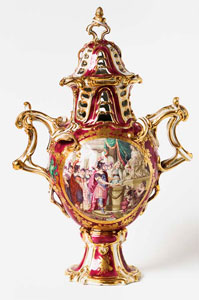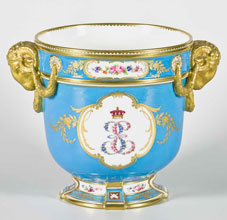The Ceramics Collection
 From ceramic objet d’art, to enhance the Mansion’s decorative scheme, to grand dinner services for lavish entertaining in the Dining Room, or practical pieces for everyday use, Tatton Park's ceramics collection reflects the varying demands of a grand family in their country seat.
From ceramic objet d’art, to enhance the Mansion’s decorative scheme, to grand dinner services for lavish entertaining in the Dining Room, or practical pieces for everyday use, Tatton Park's ceramics collection reflects the varying demands of a grand family in their country seat.
Chelsea Vase c1770/1
One of Tatton’s many treasures is a claret-ground Chelsea-Derby potpourri and cover of soft-paste porcelain, modelled in the French Rococo taste. Of baluster shape, one face shows scenes from classical mythology of Aneas offering a sacrifice to Apollo.
The reverse shows a contemporary scene outside an inn, probably set in one of the villages on the outskirts of London – perhaps Highgate, Hampstead or Islington. The vase was manufactured in Lawrence Street, Chelsea c 1770/71.
This piece is first recorded on the Tatton Park inventory in 1920 and can now be seen in the Card Room.
Minton Dessert Service c. 1865 to 1880s.
 The Tatton Park Dining table is set with a Minton Bleu Céleste dessert service bearing the cipher “E.E” under a baron’s coronet, which commemorates the rise of William Tatton Egerton to the baronetcy in 1859. It was purchased from Thomas Goode & Co., South Audley Street, London.
The Tatton Park Dining table is set with a Minton Bleu Céleste dessert service bearing the cipher “E.E” under a baron’s coronet, which commemorates the rise of William Tatton Egerton to the baronetcy in 1859. It was purchased from Thomas Goode & Co., South Audley Street, London.
The pieces date from 1863 with additions through to 1882, which suggests that replacements and new serving dishes were added to the original set as pieces were broken and as dining fashions changed.
The image to the right shows an ice pail from the service.
Two-handled Chocolate Cup and Cover – c. 1800 to 1810
The drinking of chocolate became popular in Europe after its discovery in the “New World” by the Spanish. The first recipe published in an English text for a sweetened chocolate drink with milk and water appeared in 1652. During the 18th century the drinking of chocolate increased in popularity as chocolate was believed to have restorative and medicinal powers. The chocolate cup, cover and saucer pictured here was decorated circa 1800 to 1810. It is made of soft-paste porcelain with a formal, foliate design in iron-red and gold. Though unmarked it is probably by Spode of London.
This example can be seen in the Card Room. A similar shaped example is in the V&A Museum, London.